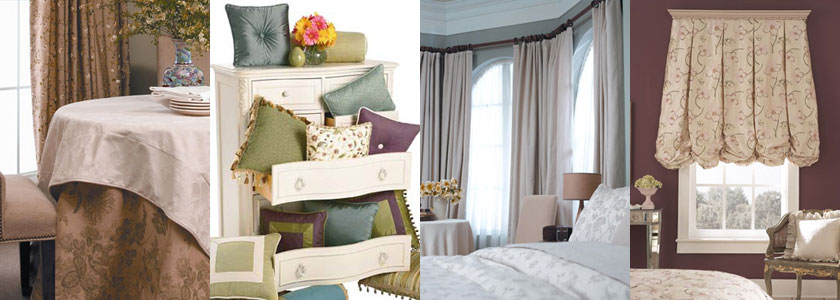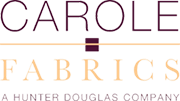CAROLE FABRICS CUTS DELIVERY TIME WITH LANSA COMMERCE EDITION
Carole Fabrics, Inc., a Hunter Douglas company located in Augusta, Georgia in the USA, manufactures custom draperies, bedspreads, window coverings and other quality home decorations. Carole’s workroom, distribution centers, customer service facilities and showrooms comprises over 250,000 square feet. Carole used LANSA Commerce Edition to provide its customers with online order entry and inquiry, including a web-based configurator for custom orders. The web solution integrates with Carole’s MAPICS solution.
Steve Cooke, MIS manager at Carole Fabrics, says, “LANSA Commerce Edition has all the base functions and security we needed for our B2B solution, while also providing a powerful development tool to extend and customize functionality specific to our company. Previously over 40 percent of our custom orders could not be completed without calling the decorator. We cut about two days of our delivery time by getting the order right the first time.”
LANSA Commerce Edition has all the base functions for our B2B solution, while also providing a powerful development tool.
- The Challenge
- The Solution
- The Benefits
- The Future
- 2010 update: Evolved LANSA WAM-based website attracts new business
- Company and System Information
The Challenge

Carole Fabric’s customers include large department store chains, home decoration shops, design studios and freelance designers working from home. Brand names include Carole Fabrics, Tapestria, Van Roberts Upholstery and Con-Fab. Carole receives close to one thousand orders per day. The orders are a mix of cut fabric, fabric swatches, sample books and custom orders.
“Over 40 percent of the custom orders could not be made without us calling the decorator and finding out more information, often adding several days to our delivery time,” says Cooke.
“We frequently required further clarification because we found something wrong or missing on the order. Typical questions were “The length measurement is missing” or “This option cannot be added to this product” or “You asked for rings, but forgot to tell us which ring”.”
“We had seven people in our call center that proofread and processed orders the entire day. They are more than proofreaders. They required extensive product knowledge, since they must be able to read the order and visualize the completed product in order to fully understand what the decorator wants. Even with previous experience cutting or sewing in our plant, training took six to twelve months.”
“Mistakes can be expensive, especially if you have already cut the fabric. We don’t want to stop in the middle of an order and call the customer for clarification, or throw away $500 of fabric because of miscommunication. We have a few hundred people in our workshop and need to keep orders moving.”
“We didn’t want to build a website from scratch so we looked at several tools. What we liked in LANSA Commerce Edition solution is that we got the flexibility of a development tool, combined with ready to use comprehensive eCommerce functionality and built in security.”
Over 40 percent of the custom orders could not be made without us calling the decorator, often adding several days to our delivery ime.
The Solution
Fabric swatch and other yardage orders are straightforward and fit well in the standard order entry model. So, this was the first area Carole automated over the web by providing online stock inquiry, order tracking and ordering of fabric yardage. With hundreds of yardage orders per day, call center traffic could be immediately reduced.
LANSA Commerce Edition provides online order tracking directly from MAPICS, regardless of whether the orders arrived by fax, phone or electronically.
“Although the web solution shows data directly from our ERP system, it was essential that we didn’t have a direct connection to the Internet. We used LANSA’s Edge Server configuration, with a Windows ISS server in front of our network to access our iSeries. This setup gives high security with minimal network traffic,” says Cooke.
The custom orders were more problematic as taking specifics for measurements, style, lining, hem size and lots of other variations are difficult to automate. Carole uses a question and answer script they created with MAPICS’ Knowledge Base Configurator that is written in PL1 and cannot be modified, or ported to the web. With over ten thousand questions/answers and over fifteen thousand business rules, keeping two systems was unthinkable. Carole decided to write and modularize its own Configurator engine, but to retain the same MAPICS file structure.
Next came the task of making the Configurator available on the web. Cooke and his team developed the RPG engine and APIs to feed questions, allowed answers and default options to the LANSA for the Web application and to receive answers. The moment a customer clicks the ‘place order’ button, the system creates a live order in MAPICS using MAPICS ‘offline load interface’ and assigns a reference number.
The Configurator manages a question and answer dialogue. The first question is what product. When you answer, for example, ‘drapery’, it will lead you through a series of questions asking drapery related questions, then it gives you a choice of suitable linings and a list of options you can chose from, such as banding and trim. Each question is based on the previous answers. “It’s simple to use and won’t let the user answer the wrong question,’ says Cooke.
When all the questions are answered, the system creates the bill of materials, prices the order, prints the work tickets immediately and sends a confirmation email to the customer.
The Configurator was first used by call center staff and fine-tuned. The immediate benefit of using the Configurator internally was that it drastically reduced the training time of call center operators and eliminated most of the proofing process.
“We can now hire somebody off the street. All you have to do is read the script, ask the questions and key-in the answers,” says Cooke. “If you cannot answer all the questions, then we cannot take the order, because we won’t have enough information to make the product.”
After a period of internal fine-tuning, a retailer with several hundred decorators successfully piloted the web solution. Now all of Carole’s customers can create and check orders from their own desk.
“Integration with MAPICS was straight forward,” explains Cooke. “We just made the MAPICS files and fields known to LANSA.”
“Since we are such a small shop, we asked LANSA consultants to handle the web development while we concentrated on our business APIs. We met in the middle and it worked well.”
“We did the whole project in about two man weeks spread over about a six week period,” says Cooke.
We did the whole project in about two man weeks spread over about a six week period.

The Benefits
“LANSA Commerce Edition has all the base functions and security we needed for our B2B solution already built-in, while also providing a powerful development tool to extend and customize functionality specific to our company,” says Cooke.
“Our Configurator and complex custom orders could easily be customized with LANSA, allowing us to re-use existing logic and programs. Ease of ongoing maintenance was also a major plus for LANSA.”
“We cut about two days of our delivery time by getting the order right the first time. We are proud to be one of the best companies in the custom decorating industry, this is another tool we can use to help us stay there.”
“Our procedures are more efficient. We don’t have delay customers orders in our plant to get further clarification. And we have reduced fabric waste by eliminating misunderstandings and mistakes.”
“Staff who used to spend their time proof reading orders and making phone calls to clarify orders are now productive in other areas of the company.”
“Our customers have more control. We get half a dozen new customers each day signing up for the web and we haven’t even advertised the site yet.”
“The 24×7 availability is especially appreciated by our one-man shop designers and home decorators. They can go out to meet their clients all day and work on their orders in the evening.”
“What we like about LANSA is that everything on our website is in real time down to the second, without duplicating data. From the moment an order is placed, its progress can be tracked online. The moment a cutter cuts a piece of fabric in the workroom and presses the button, stock availability is updated. Likewise, when marketing comes with a new product or fabric, we add the details and formulas to the Configurator data file and a link to the marketing collateral and it is immediately available for purchase on the web,” says Cooke.
We cut about two days of our delivery time by getting the order right the first time.
The Future
“We now want to extend the web solution with cell phone access, so decorators can access the system while visiting client’s homes. You can’t drag a laptop into someone’s home and ask whether they can get their daughter to unplug from the Internet, so you can check stock availability,” explains Cooke.
“We also receive hundreds of orders for fabric swatches each day. People like to feel and touch fabrics, so the web is never going to replace real samples, but we need to make the process more efficient. Instead of printing a pick ticket, we will send the information to a screen in the cutting room, get the fabric cut, scan the fabric tag, print a shipping label and drop it in an envelope.”
“LANSA provides a powerful development tool to extend our ERP functionality and has already proven its ability to meet our ongoing business challenges and requirements,” concludes Cooke.
We now want to extend the web solution with cell phone access, so decorators can access the system while visiting client’s homes.
2010 update: Evolved LANSA WAM-based website attracts new business
Carole Fabric’s original B2B solution, as described above, was functional, integrated and superior to previous manual processes – however after serving well for over six years, the application became outdated.
Carole is in a business where style and fashion are everything. This importance does not only apply to the products Carole sells, but also to how the company presents itself through its website. The user experience of Carole’s original B2B site was not sufficient for the home designers and decorators that make up Carole’s clientele. As a result, Carole was not attracting as many new customers and losing market share to competitors.
To reverse this trend, implementation of a newer web technology was needed. Carole partnered with LANSA and decided to use Visual LANSA WAM (Web Application Module) technology to redevelop its web order process and improve its market footprint.
WAMs are a component-based web technology that use XML/XSL technology and offer the ability to deliver content in multiple formats such as HTML, WML, or XML from a single WAM component. As the underlying functionality of the original B2B application was LANSA-based, much of the existing code was reused as components, separating the business logic from the user interface. Carole’s project also involved LANSA Integrator for Invoice payment processing and Ajax and jQuery technologies.
Account inquiry and other administrative facilities were ‘WAMified’ for a better presentation, while Carole used the opportunity to also improve on core functionality – product search including thumbnail vs. detailed view, product selection/configuration and check out processing.
The new B2B application has helped Carole to achieve its objectives:
- Provide a cutting edge web presence for its designers and decorators clientele. This has resulted in attracting new customers and bringing back previously jaded customers to try the evolved website, and retain them.
- Increase repeat business
- Improve the client’s web experience via intuitive and stream-lined processes
- Channel ‘manual’ transactions (e.g. free form faxes with missing information) to web-based transactions, reducing reliance on customer support and minimizing data entry errors
- Capitalize on its existing backend architecture
www.carolenet.com is a new website allowing clients to browse fabrics and custom create products.
https://www.carolenet.com/Images/Documents/CaroleNet.wmv is a link to a promotional video showcasing the site.
Company and System Information

- Carole Fabrics, Inc., headquartered in Augusta, Georgia, has been serving the custom decorating industry since 1960 and takes pride in its reputation of quality, fashion and service. Carole’s national workroom, distribution centers, customer service facilities and showrooms comprise over 250,00 square feet.
- For more information visit: www.carolefabrics.com
- Carole Fabrics uses an IBM i5 model 520 for its production and development application server environments and Linux as the web server.
- The LANSA solution integrates with Carole Fabrics’ highly customized version of MAPICS. The system has about 200 internal users and many registered external web users.

